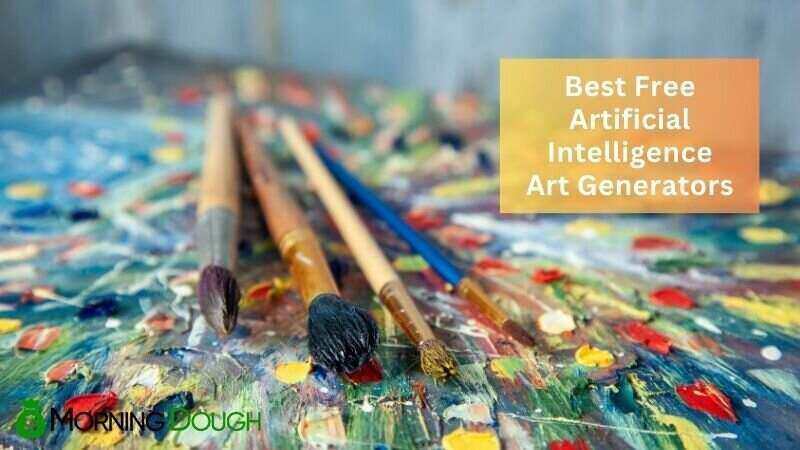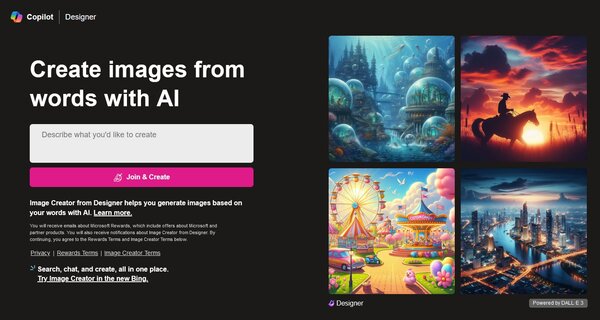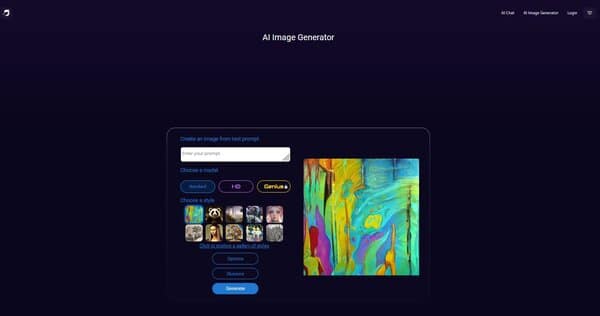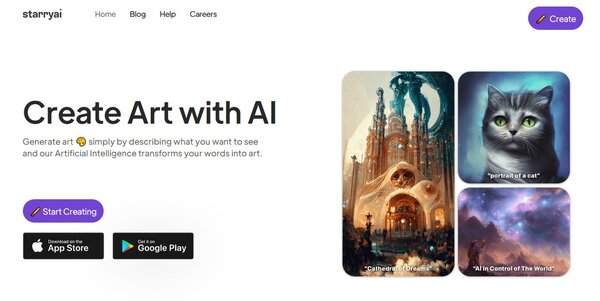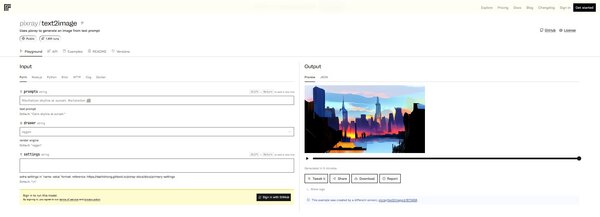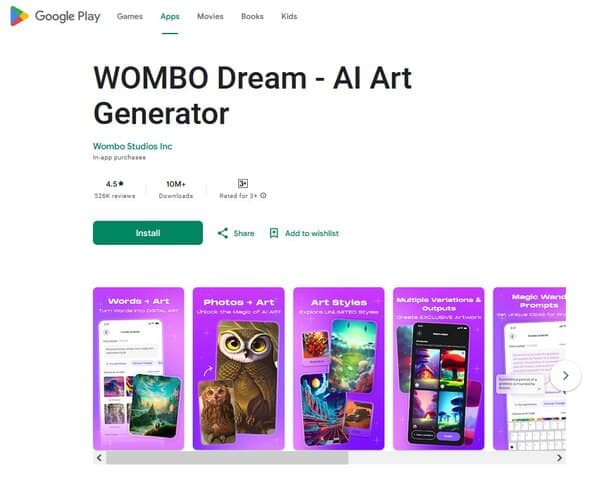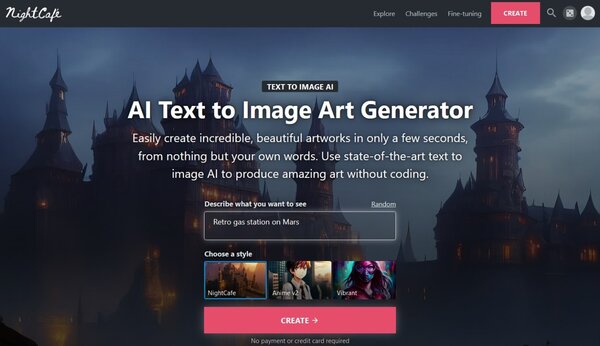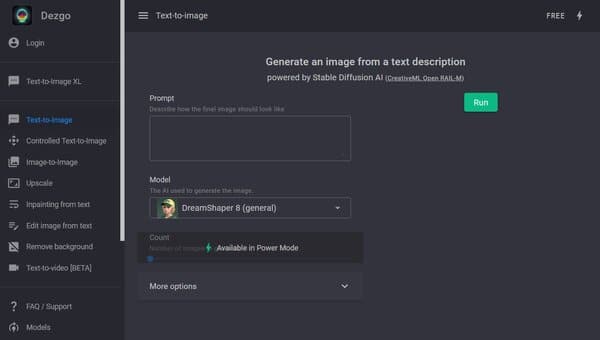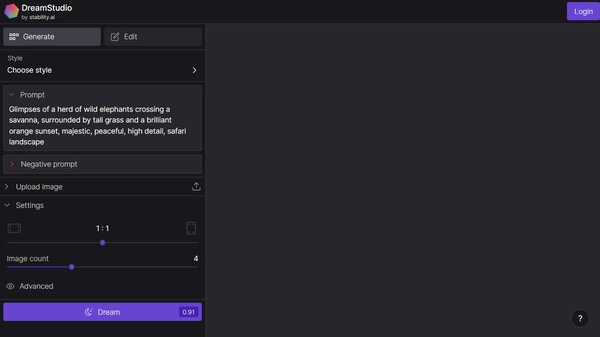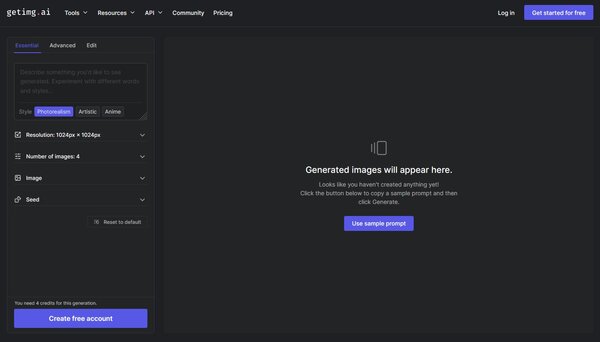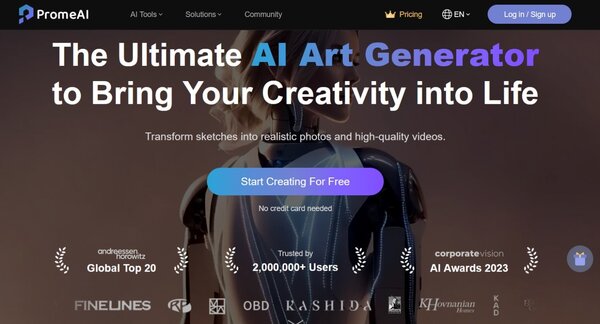10 Best Free Artificial Intelligence Art Generators
With the advent of free artificial intelligence art generators, the boundaries of creativity are being pushed further, making art creation more accessible and diverse. These tools have democratized the process of art creation, allowing both seasoned artists and novices to explore their creativity without the need for traditional art skills or materials. This evolution in art creation is particularly significant in the context of free artificial intelligence art generators, which have become a cornerstone for many in exploring and expressing their artistic visions without financial barriers.
The Need for Free Artificial Intelligence Art Generator
The demand for unique and engaging visual content has skyrocketed: from social media posts to marketing materials, the need for eye-catching images is more critical than ever. Herein lies the importance of free artificial intelligence art generators. These tools not only offer a cost-effective solution for creating high-quality, original artwork but also provide a platform for experimentation and innovation in art creation. For individuals and small businesses, the cost savings are substantial, allowing them to compete in the digital arena with captivating visuals without the hefty price tag associated with traditional art creation or stock images.
Moreover, the educational value of these free artificial intelligence art generators cannot be overstated. They serve as an excellent resource for students and educators, enabling the exploration of art and design principles through hands-on experience with cutting-edge technology. By democratizing access to art creation, these tools foster a more inclusive environment where anyone, regardless of their background or financial status, can explore their creativity.
The rise of free artificial intelligence art generators also reflects a broader trend towards personalization and customization in digital content. Users can create artworks that are tailored to their specific preferences or needs, making their digital presence more authentic and engaging. This level of customization is particularly valuable in a world where standing out in the sea of digital content is increasingly challenging.
Furthermore, the ethical and legal considerations surrounding AI-generated art highlight the need for free and accessible tools that respect copyright laws and promote responsible use. Free artificial intelligence art generators often come with guidelines and safeguards to ensure that the generated artworks do not infringe on existing copyrights, providing a safe space for creativity to flourish.
The need for free artificial intelligence art generator is multifaceted, addressing not only the practical aspects of cost and accessibility but also the broader implications for education, personalization, and ethical art creation. As these tools continue to evolve, they promise to further democratize the art world, making it more inclusive and innovative.
10 Best Free Artificial Intelligence Art Generators
- Bing Free AI Art Generator
- DeepAI.org
- StarryAI
- Pixray
- WOMBO Dream
- NightCafe
- Dezgo
- DreamStudio AI
- Getimg AI
- PromeAI
How does a Free Artificial Intelligence Art Generator work?
Free artificial intelligence art generator is a tool that leverages machine learning and neural networks to create visual art. This generator analyzes vast datasets of existing artwork to learn various artistic styles and techniques. When a user inputs a text prompt, the AI uses this learned information to generate new, unique pieces of art that reflect the input. The process is designed to be user-friendly, often requiring no technical expertise, and can produce art in a matter of seconds or minutes. Users can typically customize their creations by choosing different styles, aspect ratios, and initial images, which allows for a personalized artistic experience.
How to choose a Free Artificial Intelligence Art Generator?
Choosing a free artificial intelligence art generator involves considering several factors to ensure it meets your creative needs. First, assess the quality of the artwork produced by the generator. Look for examples or a gallery of images created by the AI to determine if they align with your aesthetic preferences. Next, consider the variety of styles and customization options available. A good free artificial intelligence art generator should offer a range of artistic styles and allow you to adjust settings such as resolution and aspect ratio to suit different projects.
The user interface is also important, it should be intuitive and easy to navigate for users of all skill levels. Additionally, consider the output limitations, such as the number of free images you can generate per day and whether the platform puts watermarks on the generated art. Finally, review the terms of service to understand the legal ownership and copyright implications of the art you create. Some generators may allow you to use the images for commercial purposes, while others might have restrictions. By carefully evaluating these aspects, you can select a free artificial intelligence art generator that is both free and capable of fulfilling your artistic vision.
Free Artificial Intelligence Art Generator
1. Bing Free Artificial Intelligence Art Generator
Bing free artificial intelligence art generator is an innovative tool developed by Microsoft, leveraging the power of artificial intelligence to transform textual descriptions into vivid, detailed images. This platform, accessible through Bing, allows users to input descriptive text, which the AI then interprets to generate images that match the given descriptions. It’s built on the advanced capabilities of DALL·E 3, a model created by OpenAI, known for its precision in understanding and visualizing complex prompts. The free artificial intelligence art generator is designed to cater to a wide range of users, from professionals seeking creative visuals for projects to individuals exploring the boundaries of their imagination. It stands out for its ease of use, offering a straightforward interface where users can simply type in their ideas and see them come to life. The tool also emphasizes responsible use, incorporating safeguards to prevent the creation of harmful or inappropriate content.
What does Bing Free AI Art Generator do?
Bing Free AI Art Generator serves as a bridge between imagination and visual representation, enabling users to create custom images based on textual prompts. This free artificial intelligence art generator is adept at understanding a wide array of descriptions, from simple concepts like a “sunny day at the beach” to more complex and creative ideas such as “a futuristic cityscape at dusk, illuminated by neon lights.” It processes these prompts through its AI model, generating images that can range from realistic depictions to abstract interpretations, depending on the user’s request. The generator is particularly useful for content creators, marketers, and anyone in need of unique visual content that doesn’t yet exist or would be difficult to capture in real life. Additionally, it offers a novel way for users to experiment with creative concepts, explore artistic styles, and even generate visuals for storytelling, presentations, or social media.
Bing Free AI Art Generator Key Features
Ease of Use: The Bing Free AI Art Generator is designed with a user-friendly interface, making it accessible for individuals of all skill levels to generate art with minimal effort.
Diverse Art Styles: Users can specify the art style for their generated images, such as watercolor, anime, or photorealistic, allowing for a wide range of creative expression.
Responsible AI Use: Microsoft has implemented safeguards and controls to prevent the generation of harmful or inappropriate images, ensuring a safe environment for creativity.
Integration with Bing Chat: The tool is seamlessly integrated into Bing Chat in Creative mode, offering a cohesive experience where users can generate both textual and visual content in one place.
High-Quality Images: Powered by DALL·E 3, the AI produces high-quality images with attention to detail, accurately interpreting and visualizing complex prompts.
Customization Options: Beyond art styles, users can experiment with different materials and settings in their prompts, offering a high degree of customization for each generated image.
Accessibility: Available directly through Bing’s website, the tool is easily accessible to anyone with an internet connection, without the need for specialized software or a Microsoft account.
Free to Use with Boosts: While the basic service is free, users have the option to use “boosts” for priority processing of their images, enhancing the tool’s flexibility and responsiveness.
These features collectively make the Bing Free AI Art Generator a versatile and powerful tool for generating custom AI art, catering to a broad spectrum of creative needs and preferences.
2. DeepAI.org
DeepAI.org is an innovative platform that harnesses the capabilities of artificial intelligence to transform textual descriptions into visual art. This free artificial intelligence art generator offers a text-to-image generator that uses advanced AI algorithms to interpret user-provided text and generate unique images. This tool is designed for a variety of users, from artists seeking inspiration to marketers in need of compelling visual content. While the generator does not produce photorealistic images, it excels in creating AI art and can be used for a range of creative or entertaining purposes.
What does DeepAI.org do?
DeepAI.org provides a suite of AI-powered tools, with the text-to-image generator being a standout feature. The free artificial intelligence art generator allows users to input descriptive text, which the AI then analyzes to produce images that are unique to each prompt. This process opens a world of creative possibilities, enabling the generation of visual content that ranges from abstract concepts to detailed scenes. DeepAI.org caters to a broad audience, including creative professionals, developers, and anyone interested in exploring the intersection of language and visual art through AI.
DeepAI.org Key Features
Text-to-Image Generation: DeepAI.org’s core functionality lies in its ability to create images from text descriptions. Users can input any phrase or concept, and the AI will generate a corresponding image, providing a visual representation of the text.
Multiple Trained Models: The platform offers a selection of trained models, each with its own strengths, allowing for versatility and customization in image generation. This ensures that users can select the model that best fits their specific needs and preferences.
API Access: For developers and businesses, DeepAI.org provides API access, enabling the integration of its AI image generation capabilities into other applications or workflows, thus expanding the potential use cases for the technology.
Community Art Feed: A showcase of images created by users is available, offering inspiration and demonstrating the diverse applications of the text-to-image generator.
User-Friendly Interface: The platform is designed with ease of use in mind, making it accessible to individuals without technical expertise in AI or machine learning.
Flexible Pricing Plans: DeepAI.org offers various pricing options, including a subscription model and pay-as-you-go plans, to accommodate different user needs and budgets.
3. StarryAI
StarryAI is an innovative Free Artificial Intelligence Art Generator that simplifies the process of turning text into visually stunning AI-generated art. This platform offers users the flexibility to create art across various domains including Art, Photos, Illustrations, or Custom Styles, catering to a wide range of aesthetic preferences from futuristic CyberPunk to timeless Portraits. StarryAI stands out for its user-friendly interface, allowing individuals to easily describe their vision through a straightforward text prompt or by leveraging the Prompt Builder tool, making the creation of personalized art accessible to everyone.
What does StarryAI do?
StarryAI serves as a bridge between imagination and visual representation, enabling users to transform their textual descriptions into unique AI-generated artworks. By offering a selection of four AI methods—Art, Photos, Illustrations, or Custom Styles—StarryAI provides a versatile platform for users to explore different artistic realms. Whether someone is looking to create a piece with a futuristic vibe or something more classical, StarryAI equips them with the tools to bring their vision to life. The platform’s simplicity, combined with its powerful AI, ensures that users can easily navigate through the process, from selecting a style to inputting their creative prompts, resulting in personalized art pieces that reflect their individual tastes and ideas.
StarryAI Key Features
Four AI Methods: StarryAI offers a choice between Art, Photos, Illustrations, or Custom Styles, allowing users to select the best fit for their artistic vision. This variety ensures that the platform can cater to a wide range of aesthetic preferences and creative needs.
Style Selection: Users can choose from a diverse array of styles, including futuristic aesthetics like CyberPunk and timeless classics like Portraits. This feature enables users to tailor their creations to match their desired look and feel.
Prompt Builder Tool: For those seeking guidance or inspiration, StarryAI’s Prompt Builder tool simplifies the process of crafting a text prompt. This tool assists users in describing their vision, making the art creation process more accessible to individuals regardless of their artistic background.
User-Friendly Interface: The platform is designed with simplicity in mind, ensuring that users can easily navigate through the art creation process. This user-friendly approach lowers the barrier to entry, making AI art generation accessible to a broader audience.
Personalized Art Creation: StarryAI empowers users to create personalized art pieces by transforming their text descriptions into visual art. This feature highlights the platform’s ability to bring individual ideas and visions to life, offering a unique avenue for creative expression.
4. Pixray
Pixray is an innovative image generation system that synthesizes a variety of advanced concepts, including Perception Engines, CLIP guided GAN imagery, and unique modifications like CLIPDraw, to create a versatile and powerful tool for visual creation. It stands out by leveraging image augmentation, iterative optimization against classifiers, and effective navigation of latent space, making it a comprehensive solution for generating images from textual descriptions. Pixray is not just a platform but also offers a Python library and command line utility, making it accessible for developers and creatives alike who wish to explore new dimensions of image generation through AI.
What does Pixray do?
Pixray transforms the process of creating art by allowing users to generate images from textual inputs. This capability is rooted in its use of artificial intelligence, particularly through the integration of CLIP models and various generative techniques such as GANs and Diffusion models. Users can input descriptive text, and Pixray interprets these descriptions to produce visual representations, ranging from realistic images to abstract art. This unique approach opens up endless possibilities for creativity, enabling both artists and non-artists to bring their imaginations to life in a way that was previously unimaginable. Whether for professional projects, personal exploration, or educational purposes, Pixray offers a new avenue for visual expression.
Pixray Key Features
Versatile Image Generation: Pixray combines several advanced AI techniques, including GANs and diffusion models, to offer a wide range of image generation capabilities. This versatility allows users to create everything from photorealistic images to abstract art, depending on their input text.
CLIP Integration: At the heart of Pixray’s functionality is the integration of the CLIP model, which enables the platform to understand and interpret textual descriptions to generate corresponding images. This feature bridges the gap between language and visual art, making it easier for users to realize their creative visions.
User-Friendly Interface: Despite its complex underlying technology, Pixray boasts a user-friendly interface that makes it accessible to individuals with varying levels of technical expertise. This ease of use ensures that a broader audience can engage with AI-driven art creation without facing a steep learning curve.
Python Library and CLI Utility: For developers and more technically inclined users, Pixray offers a Python library and command line utility. This aspect of the platform caters to those who wish to integrate Pixray’s capabilities into their projects or workflows, providing flexibility and control over the image generation process.
Iterative Optimization: Pixray employs iterative optimization techniques to refine images based on an ensemble of classifiers. This process ensures that the generated images closely align with the user’s textual descriptions, enhancing the accuracy and relevance of the visual output.
Latent Space Navigation: Understanding and navigating the latent space is crucial for generating high-quality images. Pixray incorporates innovative methods for latent space exploration, allowing for more precise control over the characteristics and details of the generated images.
Through these key features, Pixray stands out as a comprehensive and accessible tool for AI-driven image generation, offering both creative freedom and technical sophistication to its users.
5. WOMBO Dream
WOMBO Dream is an innovative Free Artificial Intelligence Art Generator that leverages advanced AI technology to transform textual descriptions into visually stunning images within seconds. This platform caters to a wide range of creative needs, from individuals looking to craft unique pieces of art to designers aiming to conceptualize their own anime characters. By simplifying the art creation process, WOMBO Dream opens up a world of artistic possibilities to users without requiring any prior experience in art or design.
What does WOMBO Dream do?
WOMBO Dream serves as a bridge between imagination and visual representation, enabling users to generate pictures, paintings, and images through a simple text-to-image process. By inputting a textual description, users can instantly see their ideas come to life in the form of digital art. This tool is designed to accommodate a variety of artistic endeavors, whether one is looking to create abstract art, realistic landscapes, or personalized anime characters. Its ease of use and quick turnaround time make it an appealing option for both seasoned artists and those new to digital art creation.
WOMBO Dream Key Features
User-Friendly Interface: The platform boasts an intuitive design that simplifies the process of creating art from text. Users can easily navigate through the app, making art creation accessible to everyone, regardless of their technical skill level.
Versatile Art Styles: WOMBO Dream offers a wide range of art styles, allowing users to experiment with different aesthetics. From abstract and surreal to photorealistic and anime, the app caters to diverse artistic preferences.
Rapid Image Generation: One of the standout features is its ability to quickly turn text descriptions into high-quality images. This efficiency enables users to iterate on their ideas and explore various creative directions without lengthy wait times.
Accessibility: Being a free tool, WOMBO Dream is accessible to a broad audience, democratizing the process of art creation. It provides a platform for users to unleash their creativity without financial barriers.
No Artistic Skill Required: The app eliminates the need for prior art or design experience, making it possible for anyone to create beautiful and intricate images. This inclusivity encourages more people to explore their creative potential.
6. NightCafe
NightCafe is an AI-powered platform that enables users to transform their creative ideas into visual art using advanced algorithms. It stands out in the digital art space by offering a user-friendly interface that caters to both novices and experienced artists. With a variety of AI models like Stable Diffusion and DALL-E 2, NightCafe provides a playground for endless artistic exploration. Users can generate art in multiple styles, participate in community challenges, and even create bulk artwork with ease. The platform’s community-centric approach encourages interaction and collaboration, making art creation a shared experience.
What does NightCafe do?
NightCafe serves as a bridge between imagination and visual representation, allowing users to create artwork through text prompts or by modifying existing images. It simplifies the art generation process, making it accessible to anyone without the need for coding skills. The platform supports various AI models, enabling the creation of diverse art styles from photorealistic to abstract. NightCafe also offers a social dimension where creators can share their work, engage with others, and find inspiration within a vibrant community of AI art enthusiasts.
NightCafe Key Features
Multiple AI Algorithms: NightCafe leverages several AI algorithms, including Stable Diffusion and DALL-E 2, to cater to a wide range of artistic preferences. This diversity allows users to experiment with different styles and complexities in their artwork.
Community Engagement: The platform is not just about creating art, it’s also about being part of an active community. Users can publish their creations, participate in contests, and interact with fellow artists, fostering a supportive environment for creativity.
Print-on-Demand: For those who wish to bring their digital creations into the physical world, NightCafe offers print-on-demand services. This feature enables users to easily obtain physical copies of their AI-generated art.
Free Base Generations: NightCafe provides unlimited free base generations, allowing users to create and experiment without immediate cost. This encourages trial and exploration among users new to AI art generation.
User-Friendly Interface: The platform is designed to be intuitive, ensuring that users can start creating without a steep learning curve. This ease of use opens up AI art generation to a broader audience, regardless of their technical background.
7. Dezgo
Dezgo harnesses the capabilities of artificial intelligence to transform textual descriptions into compelling visual art. Utilizing the Stable Diffusion AI Prompt Model DreamShaper 8, this platform offers users a seamless experience in creating images that range from the intricately detailed to the broadly conceptual. With a user-friendly interface, Dezgo caters to both novices and seasoned artists alike, providing a suite of options that allow for customization and fine-tuning of the final image output.
What does Dezgo do?
Dezgo serves as a creative companion, enabling users to bring their imaginative concepts to life through the power of AI-generated art. By inputting text descriptions, users can leverage the DreamShaper 8 model to produce images that resonate with their envisioned themes and styles. The platform’s versatility is evident in its ability to cater to various artistic needs, whether one is looking to create portraits, landscapes, or abstract compositions. Dezgo stands out by offering a straightforward pathway from ideation to visual realization, bridging the gap between creativity and technology.
Dezgo Key Features
Customization Options: Dezgo provides a rich array of customization features, allowing users to tailor the AI’s output to their specific artistic vision. This includes the ability to adjust the model count, resolution, and even the aspect ratio of the generated image to fit portrait, square, or landscape orientations.
Advanced Settings: For those seeking more control over the AI’s creative process, Dezgo offers advanced settings such as LoRA, negative prompts, and guidance steps. These tools give users the flexibility to guide the AI in avoiding certain elements or to refine the image generation process for more precise results.
Sampler and Upscaling: The platform employs the DPM++ 2M Karras Sampler, a sophisticated algorithm that ensures the quality and coherence of the generated images. Additionally, users can upscale their creations to achieve higher resolution and clarity, making the artwork suitable for a variety of applications.
User Accessibility: Dezgo is designed with accessibility in mind, ensuring that the platform is approachable for users with varying levels of experience in AI art generation. The intuitive interface and clear options make it easy for anyone to start creating without a steep learning curve.
8. DreamStudio AI
DreamStudio AI is an innovative platform designed to harness the power of artificial intelligence for the creation of digital art. It enables users to transform their ideas into unique visual pieces with ease. The interface is user-friendly, catering to both seasoned artists and beginners alike, and it operates by taking textual input and converting it into compelling imagery. This tool leverages advanced algorithms to interpret the nuances of language and visual aesthetics, providing a seamless bridge between human creativity and machine precision.
What does DreamStudio AI do?
DreamStudio AI acts as a creative partner, taking descriptive text prompts from users and turning them into vivid, detailed images. It serves a broad spectrum of purposes, from generating concept art for projects to providing visual inspiration for writers and content creators. The technology behind DreamStudio AI analyzes the text for visual cues and context, crafting artwork that ranges from realistic to fantastical, depending on the user’s input. This process democratizes art creation, making it accessible to those without traditional artistic skills and offering a new tool for experienced artists to explore and expand their creative horizons.
DreamStudio AI Key Features
Intuitive Text-to-Image Conversion: DreamStudio AI’s core functionality lies in its ability to convert text descriptions into high-quality images. This feature allows users to simply type in a description of the scene or object they envision, and the AI works to bring that vision to life visually.
Diverse Artistic Styles: The platform supports a multitude of artistic styles, enabling users to experiment with different genres and aesthetics. Whether one is looking for a watercolor effect, pixel art, or hyper-realistic renderings, DreamStudio AI can cater to a wide array of artistic preferences.
Customization Options: Users have the ability to fine-tune their creations by adjusting various parameters. This level of customization ensures that the output aligns closely with the user’s original concept, providing control over the final image’s look and feel.
User-Friendly Interface: DreamStudio AI boasts a clean and straightforward interface, making it accessible for individuals of all skill levels. The simplicity of the design ensures that users can focus on the creative process without being overwhelmed by complex tools or settings.
Rapid Generation: Speed is a significant advantage of using DreamStudio AI. The AI quickly processes the input and generates artwork in a matter of seconds, streamlining the creative workflow and allowing for rapid iteration and development of ideas.
9. Getimg AI
Getimg AI is a versatile tool designed to transform textual descriptions into high-quality, photorealistic images. Leveraging the capabilities of Stable Diffusion XL, it offers users the ability to generate images at a resolution of 1024px by 1024px, catering to a variety of creative needs. Whether for individual artists, designers, or businesses, Getimg AI provides a platform to create unique visual content without the need for traditional stock photos.
What does Getimg AI do?
Getimg AI serves as a bridge between imagination and visual representation, enabling users to generate images from text prompts. With a selection of over 60 Stable Diffusion-based AI models, users can craft images in styles ranging from photorealism to cartoons and 3D renders. The tool is designed to be user-friendly, allowing for simultaneous generation of up to 10 images, which can be used across various applications such as AI art, anime art, stock photos, wallpapers, blog images, character design, logo design, fashion, interior design, social media assets, 2D game assets, and marketing materials.
Getimg AI Key Features
Text to Image AI Generator: Getimg AI’s core feature is its ability to convert text prompts into visually stunning images. This feature supports creativity and experimentation, offering users the freedom to explore different artistic directions with ease.
Multiple AI Models: The platform boasts a diverse range of over 60 AI models, providing users with a broad spectrum of styles to choose from. This variety ensures that the generated images can match the specific aesthetic or thematic requirements of any project.
Batch Image Generation: Efficiency is key with Getimg AI, as it allows for the generation of multiple images at once. This batch processing capability is particularly useful for users who need to produce a large volume of images or wish to compare different iterations of a single concept.
Custom AI Models with DreamBooth: For those seeking a more personalized touch, Getimg AI offers DreamBooth, a feature that enables the creation of custom AI models. This allows users to generate images that are tailored to their unique style or brand identity.
Real-Time AI Generator: The Real-Time AI Generator feature provides immediate visual feedback as users write their prompts, making the creative process more dynamic and interactive.
Image Editor: Getimg AI includes an image editor with various AI pipelines and utilities, simplifying the process of refining and adjusting generated images.
AI Canvas and Outpainting: The AI Canvas offers an infinite workspace for artistic creation, while the outpainting feature allows users to expand images beyond their original borders, pushing the boundaries of traditional image generation.
ControlNet: With ControlNet, users can guide the AI using their own images, offering an unprecedented level of control over the image generation process.
API Integration: For developers and businesses, Getimg AI provides an API for easy integration, enabling the incorporation of AI image generation into existing workflows or applications.
10. PromeAI
PromeAI is a free artificial intelligence art generator that empowers users to transform their sketches into realistic photos and high-quality videos. It is designed to cater to a diverse group of creative professionals, including architects, interior designers, product designers, and game/animation designers. With a user-friendly interface and a powerful AI-driven design assistant, PromeAI simplifies the process of creating stunning visuals, making it accessible to over two million users worldwide. The platform has been recognized in the AI Awards 2023, indicating its impact and popularity in the field of AI-generated imagery.
What does PromeAI do?
PromeAI serves as an AI-driven design tool that streamlines the creative process for professionals across various industries. By leveraging advanced AI technology, it enables the quick creation of 3D models, realistic renderings, and detailed visualizations. The platform’s intuitive design assistants and controllable C-AIGC model style library offer a plethora of design options, ensuring high-quality outputs that can enhance communication and visualization of ideas. Whether for architectural modeling, interior design concepts, or product visualization, PromeAI provides a versatile solution for transforming creative concepts into tangible assets.
PromeAI Key Features
AI-Driven Design Assistants: PromeAI’s design assistants utilize artificial intelligence to help users create visuals with minimal effort. These assistants guide the design process, ensuring that the final product meets professional standards.
Controllable C-AIGC Model Style Library: The platform boasts a customizable library of AI-generated content (AIGC) styles, allowing users to select and apply different design aesthetics to their projects.
User-Friendly Interface: PromeAI’s interface is designed for ease of use, enabling both novice and experienced users to navigate and create designs efficiently.
Diverse Application: The tool is versatile and can be used by architects, interior designers, product designers, and game/animation designers, showcasing its adaptability to different creative needs.
No Credit Card Required for Free Tier: Users can start creating with PromeAI without the need for a credit card, making it accessible and risk-free to try out its features.
Global Recognition: Having been trusted by over two million users and recognized in the AI Awards 2023, PromeAI has established itself as a reputable tool in the AI art generation space.
Outpainting Feature: PromeAI offers an outpainting feature that allows users to extend their images beyond their original confines, providing a new level of image transformation and creative freedom.
Membership Options: The platform provides various membership packages, offering features like unlimited use of sketch rendering styles, fast image generation, and commercial licensing options for professionals.
Customer Support: PromeAI ensures that users have access to customer support, aiding them in maximizing the use of the platform’s features and tools.
FAQs on Free Artificial Intelligence Art Generator
What is an Artificial Intelligence Art Generator?
A Free Artificial Intelligence Art Generator is a tool powered by advanced machine learning algorithms designed to create visual art. It interprets user inputs, such as text descriptions or basic sketches, and transforms them into detailed images or artworks. These generators leverage vast datasets of existing art to learn styles, techniques, and the nuances of visual representation. Users can specify genres, styles, or even mimic the techniques of famous artists. The result is a unique piece of art generated in seconds or minutes, offering an accessible way for individuals to create without needing traditional artistic skills.
What is open source software?
Open source software (OSS) is a type of computer software whose source code is made available to the public, allowing anyone to inspect, modify, and enhance it. The concept of open source extends beyond the realm of software development to embody a broader set of values known as “the open source way,” which emphasizes open exchange, collaborative participation, rapid prototyping, transparency, meritocracy, and community-oriented development.
Unlike proprietary or closed source software, where only the original authors have the legal right to modify the software, open source software is accessible to anyone. This accessibility fosters a community of developers who can contribute to the software’s improvement, fix bugs, or add new features. Examples of open source software include LibreOffice and the GNU Image Manipulation Program.
Open source software is distributed under licenses that grant users the freedom to use, study, modify, and distribute the software for any purpose. Some licenses, known as “copyleft” licenses, require that any modified versions of the software also be distributed as open source. The open source model encourages the development of software in a collaborative and public manner, leveraging the collective expertise of its contributors.
It’s a common misconception that open source software is synonymous with free software; while many open source projects are available at no cost, the term “open source” primarily refers to the openness of the source code rather than the price of the software. Open source software offers several benefits, including increased control over the software, the ability to tailor the software to specific needs, and the opportunity for users to contribute to the software’s development and improvement.
How does an AI Art Generator work?
At its core, an artificial intelligence art generator operates by analyzing and processing large amounts of visual data. It uses neural networks, particularly Generative Adversarial Networks (GANs), to understand and replicate the complexities of art. The process involves two main components: the generator and the discriminator. The generator creates the art based on the input it receives, while the discriminator evaluates the art against the dataset, guiding the generator towards producing more realistic or stylistically accurate outputs. Over time, through this feedback loop, the AI learns to generate art that can be remarkably similar to human-created works.
What are the benefits of using an AI Art Generator?
The benefits of using an artificial intelligence art generator are manifold. Firstly, it democratizes art creation, allowing individuals without formal training or artistic skills to produce visually appealing artworks. It also serves as a powerful tool for professional artists and designers, enabling rapid prototyping and inspiring new creative directions. Additionally, these generators can save time and resources, automating parts of the creative process that are repetitive or labor-intensive. Finally, artificial intelligence art generators can foster a deeper appreciation and understanding of art by making the creation process more accessible and interactive.
Are there any limitations to AI Art Generators?
Despite their impressive capabilities, artificial intelligence art generators do have limitations. The quality and uniqueness of the generated art can vary, sometimes producing results that are abstract or nonsensical. These tools are also limited by the data they have been trained on, they might not capture the full range of human creativity or be able to create in styles that are underrepresented in their training datasets. Moreover, ethical considerations arise regarding originality and copyright, as the line between inspiration and infringement can be blurred when AI replicates existing styles or artworks.
How can one access and use a Free AI Art Generator?
Accessing and using a free artificial intelligence art generator is typically straightforward. Many such tools are available online, offering web-based interfaces that require no installation. Users can simply visit the website of an AI Art Generator, input their prompts, or upload initial sketches, and customize their settings based on the desired outcome. After submitting their input, the generator processes the request and presents the generated artwork, which can then be downloaded or shared. Some platforms may offer additional features, such as editing tools or community galleries, enhancing the overall user experience.
Conclusion
Exploring the world of Free Artificial Intelligence Art Generators opens up a new frontier in creativity and art production. These tools, powered by sophisticated machine learning algorithms, not only democratize art creation but also push the boundaries of what is possible in the digital age. While they come with their own set of limitations and ethical considerations, the benefits they offer in terms of accessibility, efficiency, and innovation cannot be overstated. As technology continues to evolve, so too will the capabilities of artificial intelligence art generators, further enriching our cultural landscape and changing our relationship with art.
